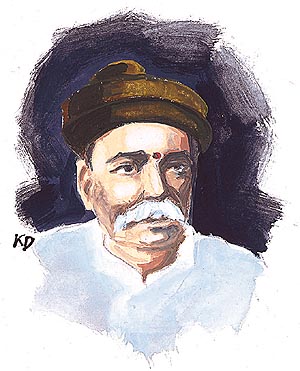Backward & Non Existent?
Backward? Yes. Existent? Just about.
The entire business model of the defence industry is licenced manufacture from other countries. Fifty years ago that was a revolutionary step. Today it is regressive and raises many questions and does not answer any.
There are two schools of thoughts on this. One thinks that India is doomed and we just cannot do it. To support their position, they point to the budget over-runs, delivery delays and indigenisation. Under-budgeting explains both time-and-cost over-runs. The indigenisation levels are another subject. No one - but no one, in the world, makes everything indigenously. The decisive aspect is reliability of supplies during wartime. That is a matter of judgment and finances. This group's motivations are doubtful - and they are frequently accused of acting for vested interests.
The second school paints a rosy picture - and the picture is definitely NOT rosy.
Easy Way Out?
India has been for the last 20 years the one of the top 3 armament purchasers in the world - along with China. India' s defence purchases exceed US$10billion every year. In the next few years, India is expected to buy US$40 billion of armaments. After that kind of spending, what will India be left with - debt and aging pieces of scrap metal.
The Problem
One single issue. Poor funding.
Two thirds of domestic development budgets are taken up by wages and other set up costs. Development activity takes up only 1/3 of the budget. DRDO which is made up of academics and scientists have been a rather poor track record in getting the GOI to understand funding, costs, time frames and monetary elbow room to explore alternative development paths. What they need are good salesmen.
Frugal Engineering
Carlos Ghosn, the current chief of the Renault-Nissan combine used the term frugal engineering to describe India's prowess in world class products at Indian costs. He followed up his talk with his walk. He has inked three deals with Mahindras for the Logan and other similar products; with Bajaj Auto for a below US$3000 car; and with Ashok Leyland for low cost commercial vehicles (in short, cheap trucks).
While other competitors had doubts about the Nano, and Osamu Suzuki and John Elliot, (is Elliot spelt like idi**) were doing a joint production of Nano comedy show, Ghosn was also (possibly) the only one who saw the threat of the Tata-Nano.
Defence Engineering
 Indian defence designers and scientists have also done a similar job in defence production.
Indian defence designers and scientists have also done a similar job in defence production.
The Akash missile development project cost less than Rs.500 crores - which is about US$100 million. For that kind of money, international arms suppliers do not give the time of the day.
of the day.
The 126 aircraft procurement under process is a prime example. The estimate started at US$6.5 billion. Recently it was estimated to cost US$10 billion - and the final bill may cross US$14 billion. With the right (domestic and international) partnerships (for sub assemblies like engine, avionics, airframe, tooling, etc.) and adequate and timely funding, the development cost will be US$ 2 billion. Production costs will be less than US$4 billion. (my estimates). IAF /DRDO estimates for the LCA are lower (I think that is more due to eagerness overkill) than realism.
The Arjuna battle tank development cost of less than Rs.350 crores - over a period of more than 15 years. That is less than US$100 million - over 15 years. What are we talking about? With (not so amusing) low budgets, what elbow room do those designers and scientists have to explore and develop alternatives? If they have delivered a working model, with production plan in place, it is the cheapest battle tank development in the world. With timely and adequate funding, these development cycles and design variations can be speeded up.
India plans to buy 6 numbers of C-130 Hercules transport aircraft at a cost of US$1 billion. The C-130 aircraft has now been in production from 1955, for mor e than 50 years (yes, for 50 years, with technology refreshments). This C-130 aircraft has now been in production for more than 50 years. A clean slate development of such an aircraft, with frugal Indian engineering, costs less than 100 million to develop. Production cost will not be more than US$200 million.
e than 50 years (yes, for 50 years, with technology refreshments). This C-130 aircraft has now been in production for more than 50 years. A clean slate development of such an aircraft, with frugal Indian engineering, costs less than 100 million to develop. Production cost will not be more than US$200 million.
Can India continue to starve our engineers, designers and industry of funds, orders, business - and lavish spending on foreign industry. These dual standards are costing the Indian tax payers big money - and more importantly, compromising India's defence preparedness. And the the defence forces face the prospect of fighting a war with inadequate armament and training.
Can we do it
Fortune 500 companies entrusted the biggest software problem the world had, the Y2K problem, to the Indian software industry. We had it licked in less than 3 years time. The Indian Government trusts foreign companies - but not Indians companies with defence production. How much more short sighted and regressive can they get?
The ISRO Antrix commercial space launch business is now beginning to challenge world leaders - and developed at Indian costs and world class technology.
The Brahmos collaborative development is another success story.
India needs to develop greater capability - in house, in time and based on global perspectives. This shopping around gets us the contempt (or the patronising attitude) that we deserve.







 follow Gandhiji - and Zimbabwe's state of affairs is well known.
follow Gandhiji - and Zimbabwe's state of affairs is well known.